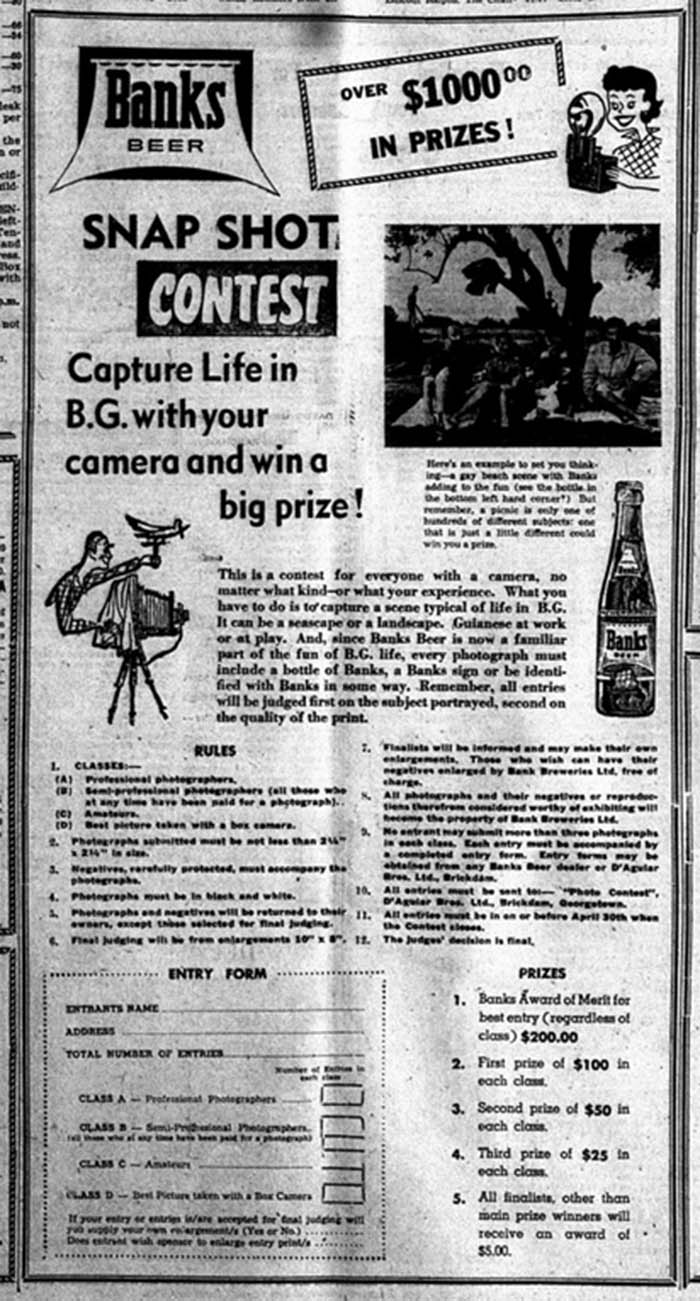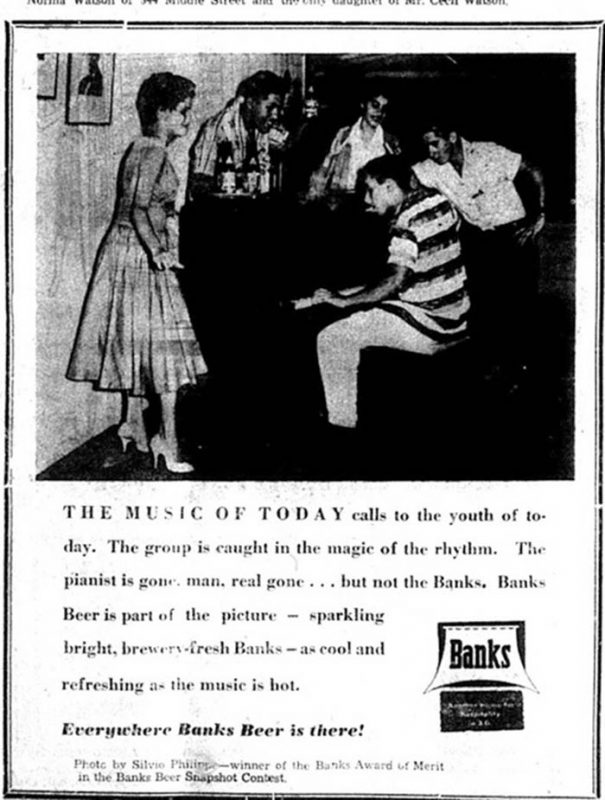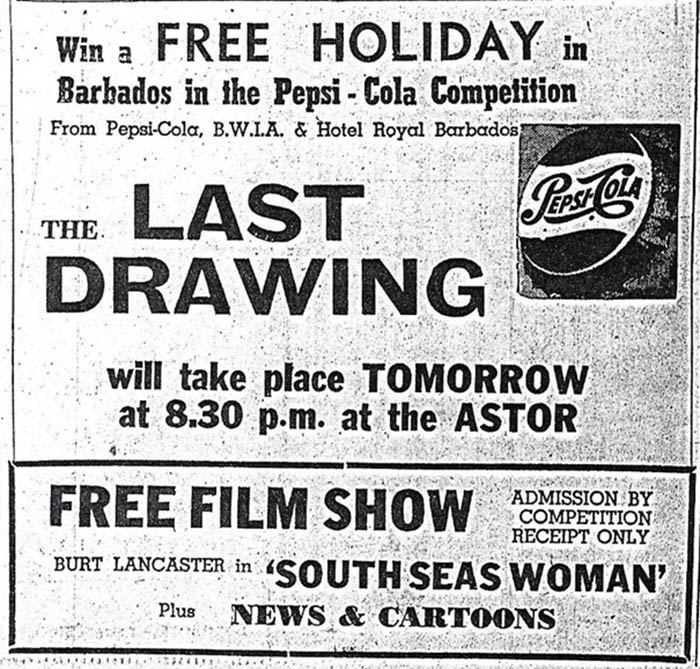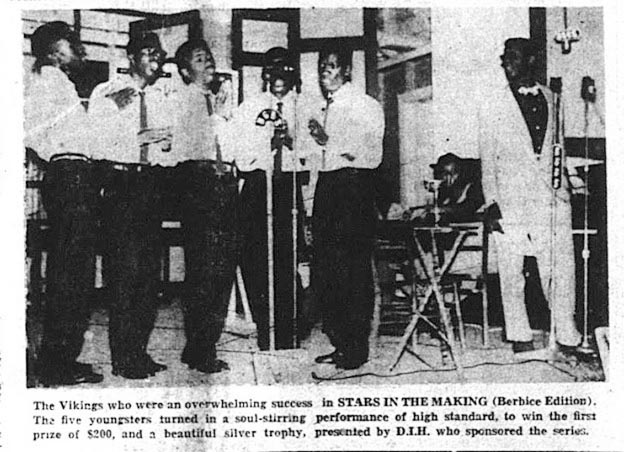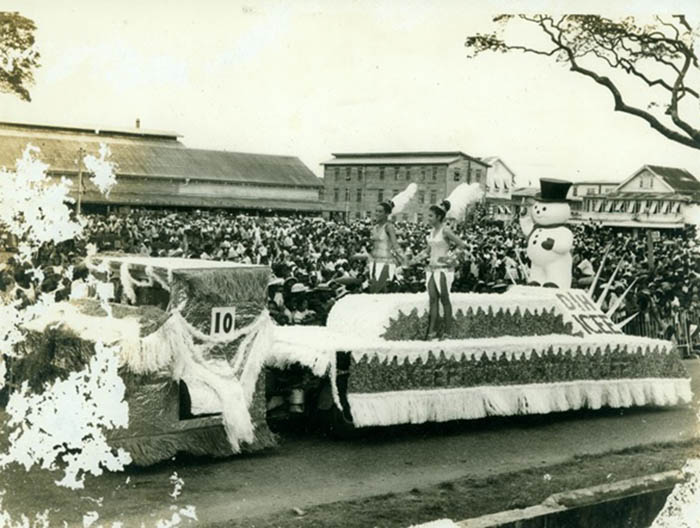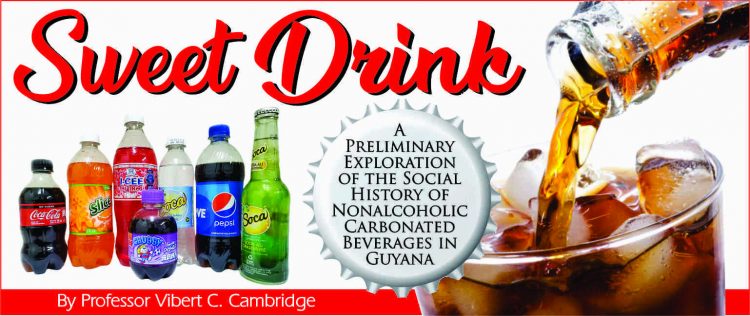 Tie-in marketing is an approach in which a company purposefully creates an association between the company, its products or services, and whatever is trending or hot in the collective consciousness at that moment. Since 1956, the hot beverage in British Guiana has been Banks Beer. In 1955, under the slogan “people’s capitalism,” Peter D’Aguiar launched the public company Banks Breweries Ltd, the first brewery in British Guiana. It made good sense as an import substitution. Beer and other malted beverages had previously been imported. Substantial amounts of beer, ale, and stout were consumed in the hot and humid colony.
Tie-in marketing is an approach in which a company purposefully creates an association between the company, its products or services, and whatever is trending or hot in the collective consciousness at that moment. Since 1956, the hot beverage in British Guiana has been Banks Beer. In 1955, under the slogan “people’s capitalism,” Peter D’Aguiar launched the public company Banks Breweries Ltd, the first brewery in British Guiana. It made good sense as an import substitution. Beer and other malted beverages had previously been imported. Substantial amounts of beer, ale, and stout were consumed in the hot and humid colony.
The term “people’s capitalism,” although seemingly oxymoronic, was brilliant in the context of the political jargon of the time. Share price was BG$1. This allowed working-class people to invest in the company. It was a master stroke at a time when the mobilization of working people was seen as the province of left-leaning agencies, such as trade unions, and Marxist-oriented vanguard political parties, such as the People’s Progressive Party (PPP) — the Jaganites and the Burnhamites. The PPP was British Guiana’s first mass party. It was founded in 1950, and in 1953, it won the colony’s first elections based on universal adult suffrage. As previously mentioned, it was expelled from office for its pro-Communist posturing after only 90 days.
The creation of Banks Breweries accelerated D’Aguiar’s political life, which began in 1953 when he was one of the 131 candidates in the general elections. More important, the
product, Banks Beer, was a symbol of Guianese achieve-ment. It was a symbol of pro-gress. Banks Beer was a hit. By 1961, the beer was also being bottled in Barbados.
D’Aguiar drew upon this success to market his company’s non-alcoholic beverages. In 1959, Banks Beer organized the Banks Beer Snapshot competi-tion. With $1,000 in prizes, it was organized under the banner “Capture Life in BG with your Camera and Win a Prize.” The company’s promotion stated: “This is a contest for everyone with a camera, no matter what kind — or what your experience. What you have to do is capture a scene typical of life in BG. It can be a seascape or a landscape. Guianese at work or at play. And, since Banks Beer is now a familiar part of the fun of BG life, every photograph must include a bottle of Banks, a Banks sign or be identified with Banks in some way. Remember, all entries will be judged first on the subject portrayed, second the quality of the print.”
The winning photographs were exhibited around the country, including at the YMCA in New Amsterdam during August 1959. The company used the winning photograph by Silvio Phillippe in its advertising campaigns. The competition positioned modern Banks Beer, a symbol of progress, as a national brand associated with all aspects of Guianese life. It also had a positive effect that extended to the company’s sweet-drink products — Pepsi Cola, I-Cee, and Club. The competition also spiked the sale of photography materials in the colony. The competition’s closing date had to be extended to accommodate the arrival of photography materials, especially printing paper.
The tie-in strategy was more obvious in the Pepsi-BWIA Competition, which ran in 1961. The top prize was a trip to Barbados, and Pepsi had tie-ins with British West Indian Airways’ new Viscount service (BWIA-Viscount), Hotel Royal Barbados, and Banks (Barbados) Brewery. In addition to trips to Barbados with stays at Hotel Royal and a conducted tour of Banks
(Barbados) Brewery, picnic coolers and beach bags were offered. The winners’ names were published in the daily newspapers. This additional publicity had a multiplier effect.
By 1969, the two companies, Banks Breweries and DIH, merged to create Banks DIH. The new company headquarters were moved to Thirst Park in Ruimveldt. This 32-acre campus was a powerful visual statement of achievement and progress under capitalism. Thirst Park featured modernist architecture. The central structure, the rotunda, was designed by Polish Architect Marian Dorr-Dorynek and at that time, was valued at $7 million.
Synthesizing
The sweet drink wars provided a tutorial in the art and science of creating desire in British Guiana. The apparent success of the proof-of-purchase competitions had a ripple effect across the wider economy. For example, between 1959 and 1961, at least 12 commercial entities organized some type of proof-of-purchase competition. They included Argosy Co Ltd (with its Refrigerator Competition), Carnation Milk, Continental Biscuits, Milk Maid, Majeed Shops, and Sterling Soap.
The big bottlers were also aware of the potential of celebrity endorsements in advertising. In 1957, the likeness of Frank Worrell, the celebrated captain of the West Indies cricket team, was used in a Brylcreem advertisement. In 1962, Joseph “Reds’’ Perreira, a rising sports commentator, was recruited by the Rahaman Soda Factory to promote Coca-Cola to sports clubs and housewives. On his return to Guyana in 1967 after a sojourn in the UK, he was recruited by John Ford of Wieting & Richter’s CSID. He was asked to change his moniker from “Reds” to “Juicee” Perreira to be the spokesman for the Juicee brand. As Sir Ronald Sanders recalled, “we almost had John Arlott [the distinguished BBC cricket commentator] handing over test match cricket commentaries to ‘Juicee’ Perreira. Fortunately, ‘Reds’ could not be persuaded.”
Proto-corporate social responsibility
Community relations were essential during the sweet-drink wars. During the period under review, all the major bottlers in Guyana engaged in some form of corporate social responsibility. The major recipients of this support were public sports events, national festivals, musical ensembles, musical events, and radio talent shows. For example, Banks DIH sponsored the Berbice edition of Stars in the Making, a talent show broadcast in 1959 on the new British Guiana Broadcasting Service (BGBS).
Banks DIH was also known for its support of athletics and other sports events, as well as public spectacles, such as steelband tramps and float parades. In his essay “Banks, Thanks! Celebrating 50 years, 1955 to 2005,” Godfrey Chin situated the beginning of the company’s association with the festival arts in the mid-1950s when it sponsored the annual Christmas steelband tramps. “This sponsorship,” he noted, “gave the underprivileged pan yards the impetus to be stars in our local community.” Among the memorable costumed bands sponsored by Banks DIH across the years were Banks of the Nile (1958), Helen of Troy (1961), Let Freedom Ring (1966), and Birth of a Nation (1970).
Wieting and Richter was known for its support of major national musical events and the sponsorship of musical ensembles. The British Guiana Music Teachers’ Association’s first annual report stated that F Harold Martin-Sperry, a Wieting and Richter senior executive, was an active member who gave an address on the symphony in the association’s public education programme.
In 1952, Martin-Sperry was the president of the inaugural British Guiana Music Festival. This event was affiliated with the British Federation of Music Festivals, of which Her Majesty Queen Elizabeth II was the patron. By all accounts, the inaugural festival was a success. According to Lloyd Kandasammy’s “A Brief History of British Guiana Music Festivals,” “at the closing of entries on 31 March 1952, a grand total of 974 applications for the various categories of the competition had been submitted to the Festival’s Committee. Of this figure, 728 entries were from Demerara, 186 from Berbice and 60 from Essequibo.”
Lt Col C M Bernard, OBE, ED, MA, another Wieting and Richter senior executive, appears to have been president of the British Guiana Music Festival from the late 1950s to the mid-1960s. Martin-Sperry and Oscar Dummett performed in A Concert of Guianese Music, organized by the BG Music Teachers’ Association during Guianese History and Culture Week 1958. Dummett performed the piano solo “Valse des Ombres,” composed by Martin-Sperry. Dummett’s “A Canticle of Love” and “Slavonic Love Song” were performed by the tenor Compton Pooran. Wieting and Richter also sponsored musical ensembles, such as the Kaietukians Juicee Steel Band.
The Rahaman Soda Factory and the Rahaman family have been associated with the promotion of basketball in Guyana. According to one family member, “the Rahaman family was involved in bringing the Harlem Globetrotters to Guyana twice, [and] supported Schuffler’s aim to introduce basketball in Guyana.” John Yates, a member of the Eagles Basketball Club during the early 1960s, said that Red Spot, a Republic Soda Factory brand, funded the inaugural Red Spot Caricom Basketball Championship, in 1981. Teams from Antigua, the Bahamas, Grenada, Guyana, Jamaica, Suriname, and Trinidad and Tobago participated in the event, which was held in Guyana. Jamaica emerged as the winner of the competition. Each participant was provided with a commemorative medallion. The Rahaman Soda Factory also “supported cricket teams in all 3 counties and introduced the Rahaman Cup for [a competition between] the East Indian Cricket Club (EICC) and Cosmos, [formerly Chinese Sport Club].” In a comment to the first installment in this series, 19CAGriffith48 wrote, “W&R also sponsored a soft-shoe football team that played at the Parade Ground on Middle Street between Carmichael & Waterloo Street on Saturday afternoons.”
Employee relations, especially scholarships to support the post-primary education of employees’ children, has emerged as an important element in the current social responsibility portfolios of the dominant companies in the sweet drink industry.
The sweet drink industry leaders were influential in other sectors of Guyanese life, including politics. Tommy Wheating, the last member of the Wieting founding family to be managing director, was elected as an independent member to represent the Pomeroom in British Guiana’s historic 1953 legislature. He was one of the 86 independent candidates who competed in that election. They won 33.83% of the votes cast and four of the 24 seats in the legislature.
D’Aguiar, the managing director of Banks DIH, emerged as an influential figure. This encouraged political engagement. As previously mentioned, his first venture was as a candidate on the National Democratic Party 1953 slate. He sat out the 1957 election. Between 1959 and 1960, he led a vigorous public multi-media anti-Communist campaign, which included the popular street-corner film shows. In 1960, he formed the United Force political party, which was part of the coalition that led British Guiana to independence. He became the new nation’s first minister of finance. John Forde, the managing director of Wieting & Richter’s CSID, the Juicee and Star bottlers, served as the lord mayor of Georgetown from 1970 to 1972.
By the 1970s, Guyana’s bottlers, especially the rapidly growing Banks DIH, had demonstrated their capacity, including networks, to distribute nonalcoholic beverages nationwide. With this confidence, Banks DIH ventured into an international fortified food project, the PUMA beverage.
Selected Resources
Chin. G. “Banks, Thanks! Celebrating 50 Years, 1955 to 2005,” in Nostalgias: Golden Memories of Guyana 1940 to 1980. Gotha, Fl.: Chico Khan Publishing, 2007.
Kandasammy. L. “A Brief History of British Guiana Music Festivals.” In the series “History This Week,” Stabroek News, November 5, 2005. Available online at: https://www.landofsixpeoples.com/news504/ns5111050.htm
Editorial (Banks DIH), Stabroek News, March 10, 1998. Available online at: http://landofsixpeoples.com/news/nsn0310.htm

